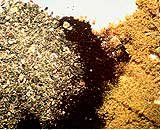
MIGUEL BOYAYANIngredients of feed: analysis guarantees breeding of new speciesMIGUEL BOYAYAN
With the purpose of determining the potential for the commercial breeding of aquatic species based on the capacity of each animal for digesting industrialized food, the Oceanographic Institute of the University of São Paulo (IO-USP) developed a system of analysis for controlling the quality of the feeds and their ingredients, on the basis of the physiological and bioenergetic aspects of fishes and shrimps. With the study ready, Professor Daniel Eduardo Lemos, the coordinator of the research, is seeking to transfer the technology in partnerships with breeders who will be able to get a more suitable identification of the feeds, and with manufacturers, in order to improve alternatives for formulation and quality control. In aquaculture, feed accounts for up to 60% of the variable costs.
The technique employed for determining the most appropriate nutrition consists of analyzing, by means of a biochemical reaction, the digestibility of the proteins, the most important components of the diet of crustaceans and of marine fish. Through a reaction in vitro, simulation takes place of the digestion of the protein by the enzymes collected from the animal. This process causes ruptures in the connections between the amino acids. The more ruptures there are, the greater the digestion of the food. “We also measured the quantity of nutrients expelled in the feces, because the more food is lost, the less digestible and suitable is the feed”, says Lemos. This is how the quality of the product and the absorption of the food by the animal are determined.
The study that resulted in this system began with a project under FAPESP’s Young Researcher Program, to give fresh support for breeding the Brazilian pink shrimp (Farfantepenaeus paulensis), a species common in a major part of the Brazilian coast and which has been bred in captivity, particularly in the decades of the 1980’s and 1990’s. According to Lemos, breeding these shrimps has been neglected, essentially because of the difficulty in feeding the animal properly. This was the period when the Pacific white shrimp (Litopenaeus vannamei) won over the market, since it gained more weight with commercial feeds. Today, it is cultivated on a large scale in Brazil (see Pesquisa FAPESP n° 92).
The key to making the industrial production of the pink shrimp viable may lie in the fact that this species is more carnivorous and needs a higher content of components of an animal origin in its food. It so happens that, because of its cost, the producers of feeds are replacing fishmeal, one of the main ingredients of this kind of food. “The replacement is with vegetable meal, which can be important for the sustained development of the production, although its use depends on the nutritional needs of the species”, Lemos says. Another aspect addressed by the researcher is the capacity for releasing nitrogen by the shrimp’s digestive process. The protein in the feeds, should it not be absorbed, ends up spilt into the environment, releasing nitrogen, which can alter the marine environment negatively.
“Using low quality food, the breeder may get as a result, besides lower growth of the species, greater pollution resulting from the process of cultivation.”The methodology developed and the knowledge obtained at the IO-USP are applied to any species of shrimp, and of fish too. Lemos is therefore carrying out studies with groups from Mexico, involving shrimps, and from Spain, with fish. “This is leading us to expect an expansion of productivity in aquaculture”, concludes the researcher, who has now started as well studies for breeding in captivity the fat snook (Centropomus parallelus), another Brazilian fish species.
The Project
Bioenergetics, Digestive Physiology and Indices of Condition During the Ontogenesis of the Farfantepenaeus paulensis Pink Shrimp and of the fat snook (Centropomus parallelus)
Modality
Young Researcher Program
Coordinator
Daniel Eduardo de Lemos – IO-USP
Investment
R$ 239,585.20 and US$ 23,342.00

